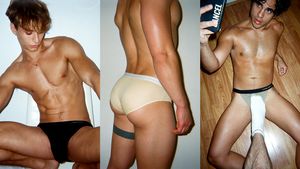UPDATE: Big Mouth co-creator Andrew Goldberg has responded to this issue in a statement on Twitter:
"We missed the mark here with this definition of bisexuality vs. pansexuality, and my fellow creators and I sincerely apologize for making people feel misrepresented. Any time we try to define something as complex as human sexuality, it's super challenging, and this time we could have done better. Thank you to the trans, pan, and bi communities for further opening our eyes to these important and complicated issues of representation. We are listening and we look forward to delving into all of this in future seasons."
The good news is more mainstream television shows are making a point to represent the LGBTQ+ community. The bad news is the intersection between sexuality and gender is still tripping them up.
Animated sitcom Big Mouth, a smart and downright weird comedy about 7th-grade kids navigating puberty, just launched its third season on Netflix. Created by Nick Kroll, Andrew Goldberg, Mark Levin and Jennifer Flackett and featuring the voices of comedy fan favorites like John Mulaney, Jenny Slate, Jordan Peele and Maya Rudolph, the cartoon explores challenging and often uncomfortable topics like teen hormones, masturbation and adult virginity.
[Spoilers ahead]
Big Mouth continues to push boundaries in Season 3, particularly with storylines about sexuality and toxic masculinity. Matthew, a gay character voiced by Andrew Rannells, finally gets his first date with a boy, leading Esquire columnist Justin Kirkland to call him "the kind of gay TV character I wish I'd had as a kid." In another episode, Mulaney's character Andrew clashes with the #MeToo movement and nearly joins a group of men's rights activists, until he realizes he's ended up at a neo-Nazi meeting.
This season also introduces new student Ali, voiced by Ali Wong, who announces to the "normies" in the class that she's pansexual. Asked to explain what that means, she says, "Pansexual means I'm into boys, girls, and everyone in between."
"I thought that was bisexual," Nick Kroll's character says.
"No, bisexuality is so binary," Ali scoffs. "Being pansexual means my sexual preference isn't limited by gender identity... It's like, some of you borings like tacos, and some of you like burritos. And if you're bisexual, you like tacos and burritos. But I'm saying I like tacos and burritos, and I could be into a taco that was born a burrito, or a burrito that is transitioning into a taco, comprende? And honey, anything else on the fucking menu."
The rest of the episode explores negative stereotypes that pansexual and bisexual people have to deal with -- but Ali's definition of pansexuality is being called out for perpetuating its own stereotypes, particularly when it comes to transgender people.
"This is a gross misunderstanding of the actual differences between bisexuality and pansexuality," one viewer responded on Twitter. "Implying bi people can't be into trans people? Not cool."
"How can we get people to understand that bisexuality is inclusive of nonbinary people, that you don't need to be pansexual to be attracted to trans people, and trans men are men and trans women are women when the media they consume is telling them the exact opposite?" another asked.
While the definitions of bisexuality and pansexuality have a lot of overlap and can vary from person to person, a more accurate explanation is that bisexual people are attracted to two or more genders, while pansexual people are attracted to all genders, or don't consider gender at all. This definition avoids the problem of separating transgender people into a "third gender" and implying that you have to be pansexual to be attracted to them.
GLAAD points out, "A common misconception about bi folks is that they seek to reinforce a rigid gender binary, but the reality is that many bi people have 'the potential to be attracted -- romantically and/or sexually -- to people of more than one sex and/or gender, not necessarily at the same time, not necessarily in the same way, and not necessarily to the same degree,' as advocate Robyn Ochs describes. The pan identity presents an additional opportunity to express attraction to multiple genders."
Big Mouth is not the first well-intentioned show to stumble over this issue. Schitt's Creek made a similar misstep with its "I like the wine and not the label" definition of pansexuality, describing a transgender person as "a Merlot that used to be a Chardonnay." (A transgender boy was always a boy, so jot that down.) While the inclusion of pansexual and bisexual storylines has been an important step forward for many viewers, pop culture still has a way to go when it comes to properly representing gender identity.
For now, we might want to be careful with the food metaphors until we've got it figured out.












































































